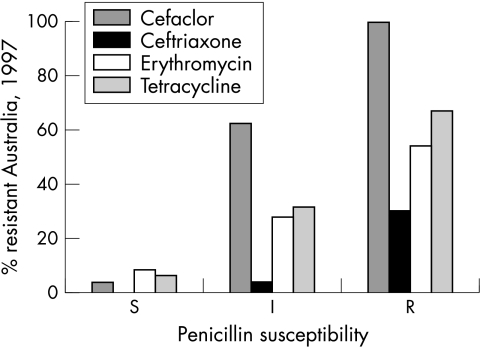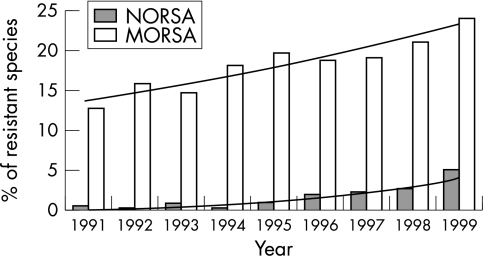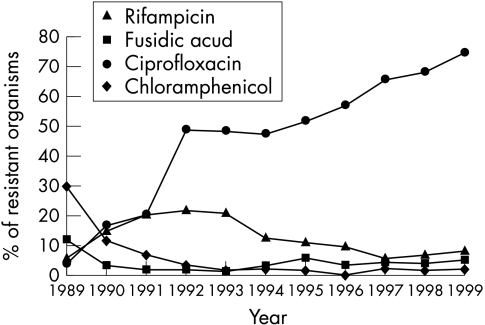Empirical antibacterial therapy in keratitis is based on the likely pathogen, the available drugs, and the severity of the condition.1 Ongoing treatment is modified by clinical response and the result of initial microbial investigations.2
There is a large degree of variation in organism type and their resistance patterns from centre to centre, and so local contemporaneous data are essential to make a rational choice of initial antibiotic therapy. Reference centres specialising in corneal disease with good microbiological backup have a key role in analysing local trends and disseminating their results. Ongoing audit is also required, as patterns of resistance are invariably changing.3
Overall, there are some common pathogens that cause acute bacterial keratitis. Streptococcal species, staphylococcal species, pseudomonas and enterobacteriaceae make up the four most common classes of infective agents and any empirical therapy has to cover all these groups.
STREPTOCOCCAL SPECIES
There have been some concerns about the lack of in vitro efficacy by fluoroquinolone in the streptococcal species.4,5 In practical terms, this has not proved to be a common problem to date in the United Kingdom and Australia.6 In vitro resistance is based on the MIC90 and assumes drug levels found following intravenous infusion. However, topical administration can produce far higher tissue levels in the cornea than those obtained by intravenous administration and can be effective in local control of streptococcal keratitis. That being said, there will be occasions where the MIC90 will be at such a level that topical administration cannot control the disease and we have certainly had clinical experience of resistant streptococci. Newer methods to assess in vitro sensitivity other than the Kirby-Bauer test that can provide a more clinically relevant definition of resistance need to be introduced.
Penicillin or cephalosporins have been traditionally recommended for streptococcal infection and are effective alternatives in keratitis.
There is, however, emergence of penicillin resistant pneumococci. Studies in Australia reveal levels of 25–30% of penicillin resistance and 34% of US isolates are resistant (Fig 1).7
Figure 1.
Penicillin and other drug resistance in Streptococcus pneumoniae. Resistance rates for sensitive (S), intermediate (I), and resistant (R) strains to various antibiotics. Overall, rate of penicillin resistance in 1989 was 1%. In 1997 the rate of penicillin resistance was 25%.
Based on these data and the prospect of emerging clinical resistance in keratitis patients, cephalosporins and penicillin will have a limited role in the future. Ciprofloxacin is not highly effective against streptococcal species. Newer quinolones such as gatifloxacin and moxifloxacin are much more rational choices.
STAPHYLOCOCCAL SPECIES
Staphylococcal species have been traditionally susceptible to β lactam drugs such as cephalosporin. Non-resistant strains show a high susceptibility to quinolones. Most series of bacterial keratitis show good efficacy with either of these choices. Resistant cases need vancomycin, which can be applied topically. Multiple resistant Staphylococcus aureus has become an increasing problem, particularly in nosocomial infection (Fig 2).8
Figure 2.
Change in rate of methicillin resistant Staphylococcus aureus. Australian Group on Antimicrobial Resistance (AGAR). NORSA = not multiresistant Staphylococcus aureus; MORSA = multiresistant Staphylococcus aureus.
These MRSA (methicillin resistant Staphylococcus aureus) species have developed new patterns of resistance to antibiotics, particularly to the fluoroquinolones (Fig 3).
Figure 3.
Emerging resistance in MRSA (methicillin resistant Staphylococcus aureus) 1989–99 (AGAR). Incidence of resistant strains to various antibiotics plotted annually.
These figures are similar if not worse in the United States.5
Ciprofloxacin is suitable for most staphylococcal species but not MRSA. If this becomes a more common cause of keratitis, then use of newer agents such as gatifloxacin and moxifloxacin will need to be considered.9
PSEUDOMONAS SPECIES
Pseudomonas is one of the most potent pathogens of the cornea and is relatively common in some populations particularly the United Kingdom. Aminoglycosides have been highly effective and resistance is uncommon.10 However, the prolonged treatment required and the tissue damage associated with the infection make the toxic side effects of treatment a common and difficult management issue.2,11
Quinolones have proved highly effective against pseudomonas to date.12,13
True resistance to ciprofloxacin is emerging particularly in India.14,15
The newer agents gatifloxacin and moxifloxacin do not have the same potency against pseudomonas, which may prove a problem if they are to be used as monotherapy.10
ENTEROBACTERIACEAE
This is the other common group of organisms that cause microbial keratitis. Cephalosporins are less effective than aminoglycosides which have been the mainstay of treatment. Quinolones are highly effective (Table 1).
Table 1.
Summary of estimated in vivo effective concentration of quinolones required with topical administration. Estimates of tissue concentrations obtained with oral and topical use in ideal conditions
| MIC90 (mg/l) | ||
| Ciprofloxacin | Gatifloxacin/moxifloxacin | |
| S pneumoniae | 2 | 0.12–0.5 |
| S aureus (all) | 0.25–2 | 0.06–0.13 |
| MRSA | R | 6.25/2.0 |
| Ps aeruginosa | 0.5(8) | 3–32 |
| Enterobacteriaceae | 0.01–0.25 | 0.01–0.39 |
| Cmax (serum, mg/l) | 2.4500 mg po | 4.2–4.5400/40 mg po |
| Aqueous (mg/l) | 0.69750 mg X3 po | |
| Cornea (mg/l) | 0.60.3% topical | |
SUMMARY
Fluoroquinolones are used as monotherapy in many centres and are highly effective (Table 1).
Tissue concentration can vary dramatically depending on associated conditions and so can make estimation of the true tissue concentration difficult. The determinants of corneal and aqueous antibiotic concentration are based on a standard concentration of drug and frequent intensive applications. However other factors such as the presence of epithelial defect and the formulation can markedly alter penetration of drug into the cornea. As previously alluded to, despite the theoretical relative resistance of streptococcal species to quinolones, clinical practice has not revealed a poor response to topical quinolones in most cases of streptococcal keratitis. Only in a small group of patients does in vitro resistance translate to poor efficacy in vivo. Both prospective trials such as the Ofloxacin Study and retrospective audit have shown equivalent overall efficacy of combined fortified and quinolone therapies.13,16,17
This lack of in vivo resistance has been explained as being a consequence of higher than predicted local tissue concentrations overwhelming a relative but not absolute resistance to ofloxacin. This has been confirmed in a series of more than 42 patients with culture proved streptococcal keratitis treated with ofloxacin (Proceedings of the International Conference on Ocular Infections, Jerusalem, 1995). However, as ofloxacin resistant organisms become more prevalent in the community, this situation is likely to change. A 5 year review published by Goldstein et al showed a significant increased resistance of Staph aureus to fluoroquinolones over the study period and questioned the use of monotherapy. Despite the increasing in vitro resistance in staphylococcal and streptococcal ulcers, topical therapy still produced corneal concentrations far in excess of the MIC values and therapy was only changed in 10% of cases despite up to 41% resistance rates for these isolates.5
The methods used to assess in vitro sensitivity, usually the Kirby-Bauer test for bacteria, need to be modified to take into account typical tissue concentrations obtained by topical treatment, and so provide more clinically relevant data.3 As resistance develops organisms will appear that will not respond even to very high local concentrations currently applied, and treatment failures will increase.
The other findings to become apparent from the clinical studies that have a significant input into clinical care are the toxicity of the medications.
Aminoglycosides produce well recognised epithelial toxicity. Prolonged intensive treatment leads to marked epithelial toxicity with pain, redness, punctate staining, and eventual retardation of epithelial healing. Non-healing epithelial defects are far more common in aminoglycoside treated keratitis. Retrospective series reveal an incidence of 5.9% of non-healing epithelial defects at 14 days in gentamicin treated eyes versus 0% in fluoroquinolone treated eyes.13
Ciprofloxacin produces white epithelial deposition in up to 16% of cases. This can mask the underlying signs and will retard epithelial healing until the drug deposits wash out.18
Retrospective audit found an increased incidence of corneal perforation in cases treated with ofloxacin.19 Fluoroquinolones are well recognised to cause spontaneous tendon rupture in otherwise well adults taking oral doses. A proposed mechanism of corneal perforation has been an increase in keratocyte apoptosis.20 Until these findings are refuted, great care should be taken in treating large deep ulcers in the elderly with ofloxacin alone.
RECOMMENDATIONS FOR EMPIRICAL ANTIBACTERIAL THERAPY IN KERATITIS
Small peripheral lesions, if not vision threatening, can be treated with quinolones alone. Corneal scrapes for culture should be taken if the patient presents to a reference centre for corneal disease.
For a large central sight threatening keratitis, corneal scrape is mandatory to both isolate resistant organisms as soon as possible and also to identify organisms that may respond poorly to initial therapy. Also this would identify unusual causes of infection earlier and allow for treatment modification.
Treatment is with quinolone plus cephalosporin, particularly in areas where streptococci and resistant staphylococci are common. Newer fluoroquinolones such as gatifloxacin and moxifloxacin offer some theoretical advantages but trials have not been completed.
Alternatively, cephazolin plus tobramycin can be used and is a reasonable choice. Increased toxicity, delayed healing, and the lack of a commercially available preparations are major deterrents.
Careful clinical and microbiological reassessment at 48 hours is essential for optimal management. A willingness to change or add antibiotics if sensitivities reveal resistance and skilful secondary management of the healing phases will determine outcome.
REFERENCES
- 1.Jones DB. Decision making in the management of microbial keratitis. Ophthalmology 1981;88:814–20. [DOI] [PubMed] [Google Scholar]
- 2.Allen BDS, Dart JKG. Strategies for the management of microbial keratitis. Br J Ophthalmol 1995;79:777–86. [DOI] [PMC free article] [PubMed] [Google Scholar]
- 3.Tuft SJ. Suppurative keratitis. Br J Ophthalmol 2003;87:127. [DOI] [PMC free article] [PubMed] [Google Scholar]
- 4.Kunimoto DY, Sharmer S, Garg P, et al. In vitro susceptibility of bacterial keratitis pathogens to ciprofloxacin. Ophthalmology 1999;106:80–5. [DOI] [PubMed] [Google Scholar]
- 5.Goldstein MH, Kowolski RP, Gordon YJ. Emerging fluoroquinolone resistance in bacterial keratitis. Ophthalmology 1999;106:1313–18. [PubMed] [Google Scholar]
- 6.Tuft SJ, Mathieson M. In vitro antibiotic resistance in bacterial keratitis in London. Br J Ophthalmol 2000;84:687–91. [DOI] [PMC free article] [PubMed] [Google Scholar]
- 7.Hoban DJ, Dawn GV, Fluit AC, et al. Worldwide prevalence of anti-microbial resistance in Streptococcus pneumonae in the sentry anti-microbial surveillance programme 1997–1999. Clin Infect Dis 2001;32(Suppl 2):S81–93. [DOI] [PubMed] [Google Scholar]
- 8.Diekema DJ, Pfaller MA, Schmidtz FJ, et al. Survey Infections due to Staphylococcus. Clin Infect Dis 2001;32(Suppl 2):S114–32. [DOI] [PubMed] [Google Scholar]
- 9.Anon. Moxifloxacin. A journey towards improving anti-microbial therapy. Clin Infect Dis 2001;32(Suppl 1).
- 10.Gales AC, Jones RN, Turnbridge J, et al. Characterisation of Pseudomonas aeruginosa isolates: occurrence rates, anti-microbial susceptibility patterns and molecular typing in the Global Sentry Anti-Microbial Surveillance Programme 1997–1999. Clin Infect Dis 2001;32(Suppl 2):S146–55. [DOI] [PubMed] [Google Scholar]
- 11.Davison CR, Tuft SJ, Dart JKG. Conjunctival necrosis after administration of topical fortified aminoglycosides. Am J Ophthalmol 1991;111:690–3. [DOI] [PubMed] [Google Scholar]
- 12.Ofloxacin Study Group. Ofloxacin monotherapy for the primary treatment of microbial keratitis. Ophthalmology 1997;104:1902–9. [PubMed] [Google Scholar]
- 13.Gangopadhyay N, Daniell MD, Weih LA, et al. Fluoroquinolone and fortified antibiotics for treatment of bacterial corneal ulcers. Br J Ophthalmol 2000;84:378–84. [DOI] [PMC free article] [PubMed] [Google Scholar]
- 14.Garg P, Scharmer S, Rayo GN. Ciprofloxacin resistant pseudomonas keratitis. Ophthalmology 1999;106:1319–23. [DOI] [PubMed] [Google Scholar]
- 15.Chaudry NA, Flynn HW, Murray TG, et al. Emerging ciprofloxacin resistant pseudomonas aeruginosa. Am J Ophthalmol 1999;128:509–10. [DOI] [PubMed] [Google Scholar]
- 16.O’Brien TP, Maguire MG, Ink NE, et al. Efficacy of ofloxacin versus cephazolin and tobramycin in the therapy for bacterial keratitis. Arch Ophthalmol 1995;113:1257–65. [DOI] [PubMed] [Google Scholar]
- 17.Hyndiuk RA, Eiferman RA, Caldwell DR, et al. Comparison of ciprofloxacin ophthalmic solution 0.3% to fortified tobramycin cephazolin in treating bacterial corneal ulcers. Ophthalmology 1996;103:1854–63. [DOI] [PubMed] [Google Scholar]
- 18.Wilhelmus KR, Hyndiuk RA, Caldwell DR, et al. 0.3% Ciprofloxacin ophthalmic ointment in the treatment of bacterial keratitis. Arch Ophthalmol 1993;111:1210–18. [DOI] [PubMed] [Google Scholar]
- 19.Mallari PLT, McCarty DJ, Daniell MD, et al. Increased incidence of corneal perforation after topical fluoroquinolone treatment for microbial keratitis. Am J Ophthalmol 2001;131:131–3. [DOI] [PubMed] [Google Scholar]
- 20.Pollack GA, McCarty DJ, McKelvie PA, et al. The in vivo effects of fluoroquinolones on rabbit corneas. ARVO Abstract 2001. [DOI] [PubMed]





